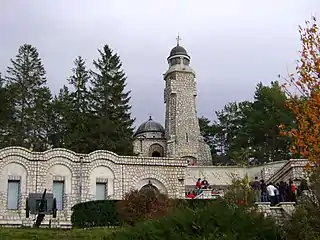Mausoleum of Mateiaș
Heroes' Mausoleum, in the commune of Valea Mare-Pravăț, Argeș County, Romania, also known as the Mausoleum of Mateiaș, is a historic monument dedicated to the heroes of the war of 1916–1918, considered by Romanians as the War for National Integration. It is located on the European Route E574 (DN 73), 11 km from Câmpulung towards Brașov, on Mateiaș Hill.

The monument is listed at position no. 1010, with the code AG-IV-m-A-14017, in the "List of historical monuments", updated by the Order of the Minister of Culture and Religion no. 2314/July 8, 2004.
History
Here in the Mateiaș area, Nămăiesti Group, led by General Traian Găiseanu and comprising the 22nd and 12th Infantry Divisions, succeeded in resisting a clearly better-equipped and much better prepared enemy, during the period 8 October to 23 November 1916 (New Style). Through the fighting here, the advance of the Central Powers towards the Wallachian Plain was stopped, but due to the breakthrough of the front on Jiu, the soldiers of the 2 divisions were ordered to withdraw - undefeated - on November 16/29, 1916, towards Târgoviște.[1]

The mausoleum was built between 1928 and 1935, according to the plans of the architects Dumitru Ionescu-Berechet and State Baloșin, by the builder De Nicolo. Limestone from Albești was mainly used in the construction.[2]
The building is composed of two parts: a horizontal one (the ossuary) which houses the bones of over 2,300 Romanian soldiers in 31 crypts, and a vertical one, in the shape of a tower with a spiral staircase leading to a pavilion. Due to the infiltration of water through the limestone walls, between 1945 and 1976 the Monument to the Heroes of Mateiaș was subjected to repair works. The earthquake of March 4, 1977 caused numerous cracks, so in 1978 consolidation work was undertaken.[2]

In the period 1980–1984, the Heroes' Mausoleum was expanded by building a parade terrace, imposing access stairs, museum rooms, a 16 m long and 3.5 m high bas-relief made by the sculptor Adrian Radu from Câmpulung. A cup made of Albești stone was also built, in which an eternal flame burns in memory of the fallen heroes in Mateiaș.[2]
References
- 95 de ani de istorie - De la Armata a 2-a, la Divizia 2 Infanterie, Gr. maior (r.) prof. univ. dr. Visarion Neagoe, Străjer în calea furtunilor - Magazin al Fundației „Mareșal Alexandru Averescu”, Anul V, nr. 9, iunie 2011 Archived 2012-09-08 at the Wayback Machine accesat 2012.07.31
- "Mausoleul de la Mateiaș, Câmpulung". Archived from the original on 2019-08-30. Retrieved 2012-07-30.
External links
- "Mausoleul Eroilor de la Mateiaș (Dragoslavele), județul Argeș". Oficiul Naţional pentru Cultul Eroilor (in Romanian).
- Dărăbanț, Nicolae (2009). "Luptele din zona Bran și Dragoslavele din Primul Război Mondial Ep. 2". Forțele Terestre, Nr. 3 (in Romanian). București. Archived from the original on 2012-01-10. Retrieved 2012-07-31.
- Popa, Petre (2004). "Două decenii de la inaugurarea Mausoleului Mateiaş şi de la editarea Cărţii Eroilor". Revista Argeș (in Romanian). Centrul Cultural Pitești. Archived from the original on 2008-10-28.
- Interactive images from the Mausoleum of Mateiaș
- "Mausoleul Mateiaș iarna". Info3D (in Romanian). București. 2015-05-03. Archived from the original on 2015-05-03.
- Clenciu, Dorian Theodor (2017-02-01). "Semnal! Mausoleul Eroilor de la Mateiaș unde sunt depuse osemintele a peste 2000 de soldați căzuți în Primul Război Mondial, supus unui atac mai puțin obișnuit". Romania Breaking News (in Romanian). București.